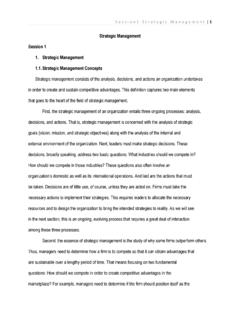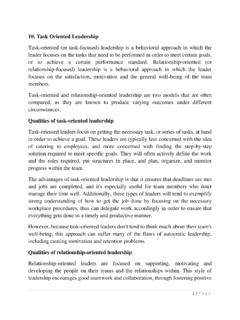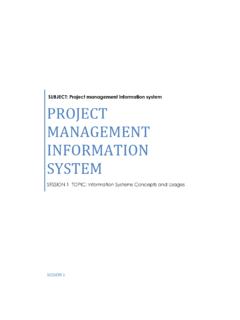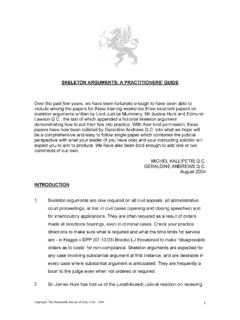Transcription of CONFLICT MANAGEMENT AND NEGOTIATION 1. Introduction …
1 SEC 1 Page 1 of 10. CONFLICT MANAGEMENT AND NEGOTIATION . 1. Introduction What is NEGOTIATION ? NEGOTIATION is a dialogue between two or more people or parties intended to reach an understanding, resolve points of difference, to gain advantage for an individual or collective, or to craft outcomes to satisfy various interests. NEGOTIATION occurs in business, non-profit organizations, government branches, legal proceedings, among nations and in personal situations such as marriage, divorce, parenting, and everyday life. The study of the subject is called NEGOTIATION theory. Professional negotiators are often specialized, such as union negotiators, leverage buyout negotiators, peace negotiators, hostage negotiators, or may work under other titles, such as diplomats, legislators or brokers. NEGOTIATION can take a wide variety of forms, from a trained negotiator acting on behalf of a particular organization or position in a formal setting, to an informal NEGOTIATION between friends.
2 NEGOTIATION can be contrasted with mediation, where a neutral third party listens to each side's arguments and attempts to help craft an agreement between the parties. It can also be compared with arbitration, which resembles a legal proceeding. In arbitration, both sides make an argument as to the merits of their case and the arbitrator decides the outcome. This NEGOTIATION is also sometimes called positional or hard-bargaining NEGOTIATION . NEGOTIATION theorists generally distinguish between two types of NEGOTIATION . Different theorists use different labels for the two general types and distinguish them in different ways. Distributive NEGOTIATION Distributive NEGOTIATION is also sometimes called positional or hard-bargaining NEGOTIATION . It tends to approach NEGOTIATION on the model of haggling in a market.
3 In a distributive NEGOTIATION , each side often adopts an extreme position, knowing that it will not be accepted, and then employs a combination of guile, bluffing, and brinkmanship in order to cede as little as possible before reaching a deal. Distributive bargainers conceive of NEGOTIATION as a process of distributing a fixed amount of value. The term distributive implies that there is a finite amount of the thing being distributed or divided among the people involved. Sometimes this type of NEGOTIATION is referred to as the distribution of a "fixed pie." There is only so much to go around, but the proportion to be distributed is variable. Distributive SEC 1 Page 2 of 10. NEGOTIATION is also sometimes called win-lose because of the assumption that one person's gain results in another person's loss. A distributive NEGOTIATION often involves people who have never had a previous interactive relationship, nor are they likely to do so again in the near future.
4 Simple everyday examples would be buying a car or a house. Integrative NEGOTIATION Integrative NEGOTIATION is also sometimes called interest-based or principled NEGOTIATION . It is a set of techniques that attempts to improve the quality and likelihood of negotiated agreement by providing an alternative to traditional distributive NEGOTIATION techniques. While distributive NEGOTIATION assumes there is a fixed amount of value (a "fixed pie") to be divided between the parties, integrative NEGOTIATION often attempts to create value in the course of the NEGOTIATION ("expand the pie"). It focuses on the underlying interests of the parties rather than their arbitrary starting positions, approaches NEGOTIATION as a shared problem rather than a personalized battle, and insists upon adherence to objective, principled criteria as the basis for agreement.
5 Integrative NEGOTIATION often involves a higher degree of trust and the forming of a relationship. It can also involve creative problem-solving that aims to achieve mutual gains. It is also sometimes called win-win NEGOTIATION . NEGOTIATION and CONFLICT MANAGEMENT are indispensable parts of each other. Where there is CONFLICT MANAGEMENT , the role of NEGOTIATION is vital to succeed in it. Either it is a big organization or small one no one can solve a CONFLICT amicably without NEGOTIATION . Both the conflicting parties are to be brought closer to negotiate with each other to reach the settlement. A negotiator is one who talks with both the parties, listen their view points and after that bring them into direct talks to remove grievances of each other. A. mediator is one who interferes in a discord to resolve it but not necessarily talks with warring parties and if dispute could be resolved by directly removing the grievances of both the parties he or she may do so accordingly.
6 Similarly solicitor also perform the same job but thru court in case of serious types of differences. The ultimate aim of all of the above is to let the group or organization move ahead smoothly free from any hurdle. When two or more parties or people have differing opinions, CONFLICT NEGOTIATION is often necessary. In the business world, the CONFLICT might be over things such as SEC 1 Page 3 of 10. contract wording, terms of a sale or just differences in personalities or work styles. No matter what type of problem, the main issue typically is exemplified in a standoff, during which neither side wants to back down. Sometimes called mediation, CONFLICT NEGOTIATION usually involves bringing in a third party to foster communication between the disputants, talking about solutions and creating an agreement that meets both parties' needs.
7 The most successful types of CONFLICT negotiations are resolved with win-win solutions, which are resolutions that are mutually satisfying for everyone involved. Many companies train their MANAGEMENT teams and human resources professionals in CONFLICT NEGOTIATION . There are several types of strategies and techniques used to resolve conflicts. Most people agree that the first step is clear identification of the issue. This step can be very important, because many conflicts are the result of poor communication and misunderstandings. Effective CONFLICT negotiators are excellent listeners who are trained to hear what each party wants as the final outcome. After the problem has been identified and the negotiator has full understanding of the motives of all parties, he or she can begin to look for ways for the parties to come to a compromise.
8 This phase of CONFLICT NEGOTIATION usually involves talking to each party separately to learn what they are willing to give up and the issues on which they will not back down. At this point, the negotiator typically creates a revised contract or agreement by incorporating the agreed-upon compromises. Sometimes, the actual meaning of the original contract does not change, but the particular wording or phrasing that might have triggered the CONFLICT is changed. The mediator then presents the new draft to both parties to see if an agreement can be reached. If a compromise is not agreed upon with the new draft , the CONFLICT NEGOTIATION typically moves into a new phase of alternative compromises and solutions. For example, if party No. 1 wants Solution A and party No. 2 wants Solution B, the negotiator might suggest a Solution C, which might incorporate parts of Solutions A and B but often involves a completely different end solution.
9 This way, both parties do not feel that the opposing party won the CONFLICT or got its way. If the parties do not agree at this point, then the CONFLICT NEGOTIATION typically moves into arbitration or litigation. Negotiator has key role in dispute resolution. If he or she is not wiser enough to analyze the discord's all aspects it won't be possible for him or her to settle it favorably and ultimately would have to apply unwanted techniques like pressure or SEC 1 Page 4 of 10. delaying tactics to subside the ire of warring parties and thereafter bring them to the NEGOTIATION table. Therefore, CONFLICT MANAGEMENT negotiations are considered lifeblood during the process of removing difference between two or more individuals or groups. In every organization CONFLICT is a routine matter but their MANAGEMENT needs full attention otherwise any failure to tackle it successfully may further aggravate the situation.
10 Well said by several that dispute spread like a disease if not contained at the very beginning that too with the help of viable techniques to resolve it with the consent of all involved in it. Negotiating for the purpose of removing any just or undue difference of opinion between two or more parties actually calls for rational analysis of the nature of dispute. Its every aspect should be analyzed keeping in view of ground realities and entire situation of the working environment of the organization. The past history of both the disputing parties is scrutinized apart from assessment of their overall attitude in performance of their duties. Most of the times a final formula is decided to settle the confrontation after complete analysis of above factors. Otherwise chances of success remain bleak. Cooperative bargaining vs.














